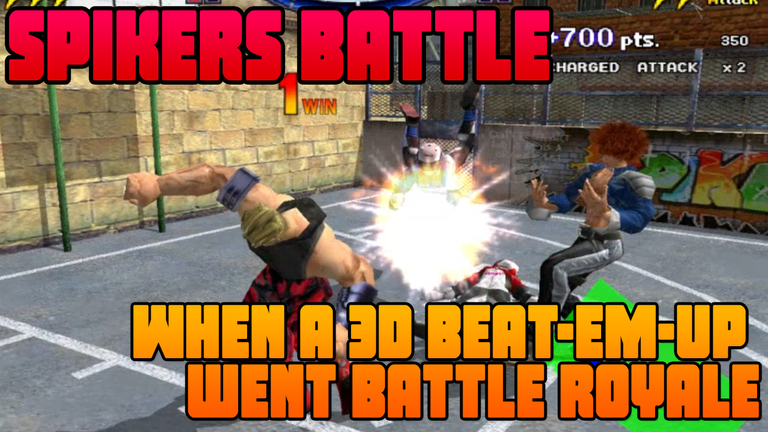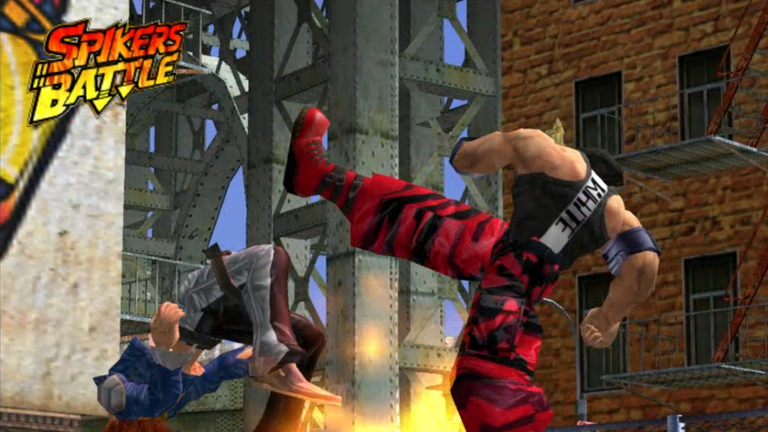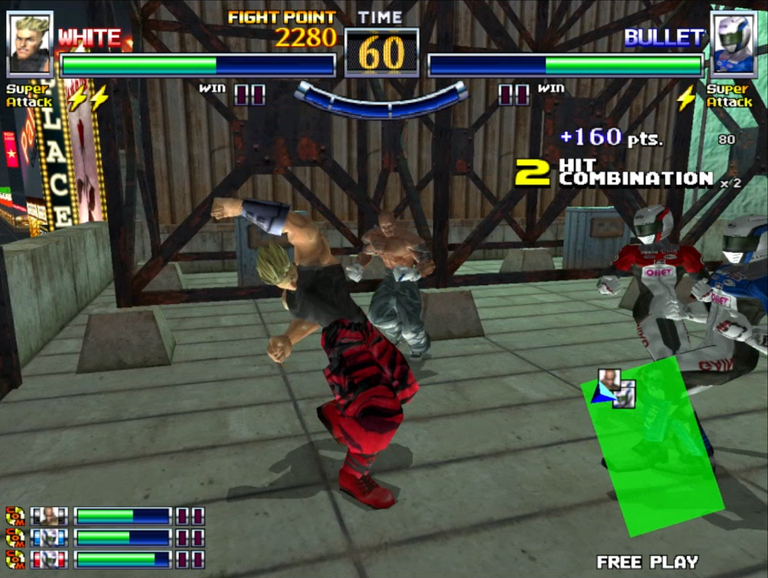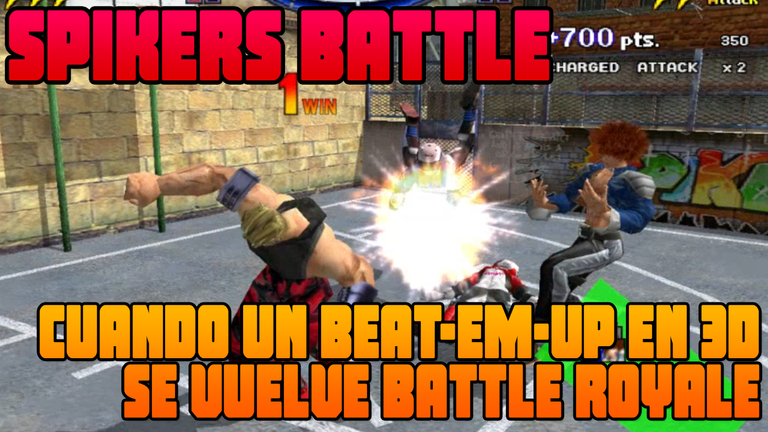

You know that most franchises tend to have that one game considered as the black sheep of the franchise, sometimes because they are a noticeable dip in quality compared to their rest of the legacy like Devil May Cry 2, killed their franchise with their performance like Bloody Roar 4, or even more uncommonly, happens to be a divisive title in a small franchise, like two or three games small, which makes it stand out within the niche fanbase it can have.
Spikers Battle is one such anomaly from SEGA's hands: Between the original, beloved but almost forgotten Spikeout (until it arrived in Like a Dragon Infinite Wealth...and having some mixed responses due to its difficulty), the still arcade exclusive fantasy spin-off SlashOut, and the fully featured standalone Spikeout Battle Street for Xbox which is still to this day the only official version with online and other expected home features compared to the straight arcade port in LAD:IW...this game not only is different in its basic premise, but also is not very fondly remembered by Japanese players.
See, while internationally the extent of Spikeout goes to either a cool 3D beat-em-up from SEGA's history that lent its gameplay to Yakuza or just another unfair coin muncher from the 90s (the latter mainly coming from some of the new audience the LAD:IW port brought since one or two achievements are tied to its completion as a mini-game), in Japan it is much, much more revered.
I've likely mentioned this already whenever I bring up Spikeout, but likely thanks to SEGA's larger arcade presence at their home turf, Spikeout seems to have been quite widespread in arcades and super popular thanks to its four player link support basically allowing anyone that gets on a cab to suddenly show up in someone else's game and continue playing in co-op.
A modality that was only common in Japan until only being emulated inofficially through the Supermodel Emulator many years later, and now officialy a few more after that, some Japanese players grew very fond and very good at playing the game, not only alone but in multiplayer.
So...what does all of that preamble come down to?
A beat-em-up battle royale?

Instead of being a straight-forward beat-em-up like every other game, Spikers Battle was a spin-off that used the same systems of its predecessors...and applied it to a free-for-all set of matches.
It reminds me of some games that have tried to mix genres before such as Guilty Gear Judgement (fighting game to beat-em-up), Mortal Kombat Mythologies (fighting game to...platformer...with the same MK controls?), but the most accurate comparison would be saying that its like the versus mode in games like Final Fight and Streets of Rage were turned into full games.
On a basic level, it doesn't falter that much due to Spikeout's gameplay design being robust in itself, but the issue likely falls on how its used. Gone are the co-op fighting against hordes and juggling weak enemies, instead replaced with fighting either three other players, or fighting bots that might behave like one.

And if you are playing alone, here applies what I would call the "If you lose, the game wins" rule.
Essentially, you'll be fighting 1 vs 3 all the time. The winner of the match is decided by whoever wins two rounds, and while the three other characters could count as separate players, of course, a win for one of them is a win for ALL of them, so you only got one spare loss against them before having to continue.
I feel like just from the concept and focus alone, this is what alienated even the most faithful Spikeout fans away from this game, and even SlashOut had a similar fate because of some mechanics being slightly toned down while balancing the game to this odd level-up system compared to improving with only raw skill and people tagging along in Spikeout. And it can feel a bit janky with how sometimes the player-oriented design to be able to get out of certain attacks and special-attack-your way out can feel annoying when you are interrupted by one, or even worse, someone else runs up to you with a flying kick when you are trying to combo an enemy.
...But if we are to take the game as it is, how well does it hold up?
Being the mook in a beat-em-up simulator

Rather than dealing with bosses that activate invlunerable frames whenever you hit them and being swarmed by five or more mooks on top of that, opponents also have a limited amount of special moves, so you can eventually wear them down into having nothing to counter any combos you land on them...but as mentioned before, sometimes it just takes a spare enemy to get inyour way.
Adding to that, while Spikeout's flow is like Metal Slug's where you can continue right where you left off if you get KO'd (so its possible to complete the game eventually if you keep continuing over and over with infinite imaginary credits credits), here since its like a fighting game's arcade mode, failing to survive the triple ambush and continuing will just drop you back to trying again.
So this game legitimately requires you to figure out how to deal with a team of three "players" going against you through 8 stages to be able to see the ending. It can easily result in the game feeling repetitive and even unfair when all it takes to end a good match is that YOU die before the rest. This is already noticeable in the fifth stage, but the sixth stage, Imperial Opera, pits you with three AI-unique characters that seem to move faster and hit harder.
And something that I hadn't mentioned about Spikeout's gameplay is that, while it is possible to do some juggles with enemies thanks to some of your moves, that opens up if playing in multiplayer with being able to juggle together an enemy and destroy their lifebar with attacks.
NOW IMAGINE THAT YOU ARE THAT MOOK, GETTING PUMMELED MID-AIR BY THREE OTHER GUYS, AND YOUR HEALTHBAR BEING ERASED INSTANTLY.
(and yes, the quality is intentionally 2000s, but that clip happened to me TODAY FEBRUARY 3RD 2024)
That is likely the biggest flaw of Spikers Battle alone that Japanese players saw: You're basically left with left options to launch and combo due to the adjustments and other enemies...but now the enemies can do deadly juggles together against you if you are really unlucky.
If you can play with a friend thouhg, then even if it might be kinda mindless at a basic level, its still a beat-em-up with a good oomph feeling...where you can go hog either against the AI together, or batter each other up. So at least for several minutes, it can be some silly fun, and if you're able to set up a full four player game, then you can bet there will be sparks of trash-talking flying.
The game also gives the round win to whoever has the highest fight score which is per-round if time runs out, so if you were to get a lead on that and run around you can still win a round even if there are three other enemies with slightly more health than you alive. But don't run too far away for too much if you don't have a sizable score lead, as it will rapidly get drained if you try to escape too often.
I think that what is neat is how this is a more colorful yet familiar take on the old streets of Spikeout complete with some new music, getting to see the old Team Spike before their redesign again and find four new playable challengers available. Even if it does come as something without any plot with how you're suddenly fighting not only random people but even yourself at times, it still 90s SEGA enough to have some charm for me. And of course, whenever the game lets you get silly with using tables, chairs or even buckets as weapons, that's fun to watch as well.
It is easy to see how this was not set to be a best seller for SEGA though: Not only SlashOut had already been kind of a dud within the hardcore fans back then, but spinning off a tight co-op action beat-em-up into Smash Bros style slugfest was very likely not what Japanese fans expected.
And the one-two that buried this franchise's chances would be that the first proper home port was relegated to the not terribly popular OG Xbox in Japan and that its combat DNA would sprout the creation of the Yakuza/Like a Dragon franchise with the same man (Toshihiro Nagoshi) behind the helm.
Then there's the fact that outside of Japan, before ROM dumps and emulators for these games floated around the internet, these games are likely to have been inexistent in arcades between the costs of Model 3 boards for Spikeout and how NAOMI boards would have been bought by arcade owners only for the big fighters like Capcom VS SNK 2 and Marvel VS Capcom 2.
With how Spikeout left the seeds for the gigantic Like a Dragon franchise, its kinda telling how even those dedicated Japanese fans, with their interest revitalized thanks to the new port in Ichiban's newest adventure, still don't think highly at all of this game.
But at the very least, thanks to the existence of emulation today, this odd piece of history is not lost to the sands of time, and is still a decent romp for a small brawler where you beat down enemies from start to end that is also playable in versus with others if you are savvy enough to configure the emulator for that.
Thanks for reading!

Spanish translation with DeepL. All screenshots were captured by myself.
Español

Ya sabes que la mayoría de las franquicias tienden a tener un juego considerado como la oveja negra de la franquicia, a veces porque son un notable descenso en la calidad en comparación con el resto de su legado como Devil May Cry 2, mató a su franquicia con su rendimiento como Bloody Roar 4, o incluso más raro, pasa a ser un título divisivo en una pequeña franquicia, como dos o tres juegos pequeños, lo que hace que se destaque dentro del nicho de fans que puede tener.
Spikers Battle es una de esas anomalías de la mano de SEGA: Entre el original, querido pero casi olvidado Spikeout (hasta que llegó en Like a Dragon Infinite Wealth... y tuvo algunas respuestas mixtas debido a su dificultad), el spin-off de fantasía SlashOut, todavía exclusivo de arcade, y el totalmente independiente Spikeout Battle Street para Xbox, que sigue siendo a día de hoy la única versión oficial con online y otras esperadas características caseras en comparación con el port arcade directo en LAD:IW... este juego no sólo es diferente en su premisa básica, sino que además no es recordado con mucho cariño por los jugadores japoneses.
Verás, mientras que a nivel internacional Spikeout se considera o bien un genial beat-em-up en 3D de la historia de SEGA que prestó su jugabilidad a Yakuza, o bien simplemente otro injusto traga-monedas de los 90 (esto último proviene principalmente de parte del nuevo público que trajo el port de LAD:IW, ya que uno o dos logros están ligados a su finalización como minijuego), en Japón es mucho, mucho más venerado.
Es probable que ya lo haya mencionado cada vez que hablo de Spikeout, pero probablemente gracias a la mayor presencia de SEGA en los salones recreativos de su país, Spikeout parece haber estado bastante extendido en los salones recreativos y haber sido superpopular gracias a su soporte de enlace para cuatro jugadores, que básicamente permitía a cualquiera que se subiera a un taxi aparecer de repente en la partida de otro y seguir jugando en cooperativo.
Una modalidad que sólo era común en Japón hasta que fue emulada inoficialmente a través del Supermodel Emulator muchos años después, y ahora oficialmente unos cuantos más después, algunos jugadores japoneses se aficionaron mucho y muy bien a jugar al juego, no sólo solos sino en multijugador.
Entonces... ¿a qué viene todo este preámbulo?
¿Un beat-em-up battle royale?

En lugar de ser un beat-em-up como cualquier otro juego, Spikers Battle era un spin-off que utilizaba los mismos sistemas de sus predecesores... y los aplicaba a un juego de combates todos contra todos.
Me recuerda a algunos juegos que han intentado mezclar géneros anteriormente, como Guilty Gear Judgement (juego de lucha con beat-em-up), Mortal Kombat Mythologies (juego de lucha con... plataformas... ¿con los mismos controles de MK?), pero la comparación más acertada sería decir que es como si el modo versus de juegos como Final Fight y Streets of Rage se convirtieran en juegos completos.
En un nivel básico, no flaquea tanto debido a que el diseño de juego de Spikeout es robusto en sí mismo, pero el problema radica en cómo se usa. Atrás han quedado los combates cooperativos contra hordas y los malabarismos con enemigos débiles, que han sido sustituidos por combates contra otros tres jugadores o contra robots que pueden comportarse como uno de ellos.

Y si juegas solo, aquí se aplica lo que yo llamaría la regla "Si pierdes, gana el juego".
Esencialmente, estarás luchando 1 vs 3 todo el tiempo. El ganador de la partida se decide por quien gane dos rondas, y aunque los otros tres personajes podrían contar como jugadores separados, por supuesto, una victoria para uno de ellos es una victoria para TODOS ellos, así que sólo tienes una derrota de sobra contra ellos antes de tener que continuar.
Creo que sólo por el concepto y el enfoque, esto es lo que alejó de este juego incluso a los fans más fieles de Spikeout, e incluso SlashOut tuvo un destino similar debido a que algunas mecánicas se atenuaron ligeramente al equilibrar el juego con este extraño sistema de subida de nivel en comparación con la mejora sólo con la habilidad bruta y la gente que te acompaña en Spikeout. A veces, el diseño orientado al jugador, que te permite esquivar ciertos ataques y salir de ellos con un ataque especial, puede resultar molesto cuando te interrumpe uno o, peor aún, cuando alguien se te echa encima con una patada voladora cuando estás intentando hacer un combo con un enemigo.
...Pero si vamos a tomar el juego tal y como es, ¿hasta qué punto se mantiene?
Simulador de ser un esbirro en un beat-em-up

En lugar de enfrentarte a jefes que activan cuadros invulnerables cada vez que les golpeas y ser acosado por cinco o más esbirros, los oponentes también tienen una cantidad limitada de movimientos especiales, por lo que puedes desgastarlos hasta que no tengan nada con lo que contrarrestar los combos que les lances... pero, como ya se ha mencionado, a veces basta con un enemigo de sobra para interponerse en tu camino.
Además, mientras que el flujo de Spikeout es como el de Metal Slug, en el que puedes continuar justo donde lo dejaste si te eliminan (por lo que es posible completar el juego si continúas una y otra vez con infinitos créditos imaginarios), aquí, como es como el modo arcade de un juego de lucha, si no sobrevives a la triple emboscada y continúas, volverás a intentarlo de nuevo.
Así que este juego requiere legítimamente que averigües cómo enfrentarte a un equipo de tres "jugadores" que van contra ti a lo largo de 8 fases para poder ver el final. Esto puede hacer que el juego resulte repetitivo e incluso injusto cuando lo único que hace falta para acabar una buena partida es que TÚ mueras antes que el resto. Esto ya se nota en la quinta fase, pero la sexta, Ópera Imperial, te enfrenta a tres personajes exclusivos de la IA que parecen moverse más rápido y golpear más fuerte.
Y algo que no había mencionado sobre la jugabilidad de Spikeout es que, aunque es posible hacer algunos malabarismos con los enemigos gracias a algunos de tus movimientos, eso se abre si juegas en multijugador con poder hacer malabarismos con un enemigo y destruir su barra de vida con ataques.
IMAGINA AHORA QUE ERES ESE ESBIRRO, SIENDO APORREADO EN EL AIRE POR OTROS TRES TIPOS, Y TU BARRA DE VIDA SIENDO BORRADA AL INSTANTE.
(y sí, la calidad es intencionadamente de los 2000, pero ese clip me pasó HOY 3 DE FEBRERO DE 2024)
Ese es probablemente el mayor defecto de Spikers Battle por sí solo que vieron los jugadores japoneses: Básicamente te quedan opciones de lanzamiento y combo debido a los ajustes y a otros enemigos... pero ahora los enemigos pueden hacer malabares mortales juntos contra ti si tienes muy mala suerte.
Sin embargo, si puedes jugar con un amigo, aunque a un nivel básico sea un poco absurdo, sigue siendo un beat-em-up con una buena sensación de empuje... en el que podéis enfrentaros juntos a la IA o golpearos el uno al otro. Así que, al menos durante unos minutos, puede ser una diversión tonta, y si eres capaz de organizar una partida completa de cuatro jugadores, puedes apostar a que saltarán chispas de insultos.
El juego también da la victoria de la ronda a quien tenga la puntuación de combate más alta, que es por ronda si se acaba el tiempo, así que si te pusieras por delante en eso y corrieras por ahí aún puedes ganar una ronda aunque haya otros tres enemigos con algo más de salud que tú vivos. Pero no corras demasiado si no tienes una ventaja considerable en la puntuación, ya que se agotará rápidamente si intentas escapar con demasiada frecuencia.
Creo que lo mejor de todo es que se trata de una versión más colorida pero familiar de las viejas calles de Spikeout, con música nueva, la posibilidad de volver a ver al antiguo equipo Spike antes de su rediseño y cuatro nuevos desafíos jugables. A pesar de que no tiene ningún argumento, ya que de repente te enfrentas no solo a gente aleatoria, sino incluso a ti mismo, sigue siendo lo suficientemente SEGA de los 90 como para tener cierto encanto para mí. Y, por supuesto, cada vez que el juego te permite usar mesas, sillas o incluso cubos como armas, también es divertido.
Sin embargo, es fácil ver que no estaba destinado a ser un éxito de ventas para SEGA: No sólo SlashOut ya había sido un fracaso entre los fans más acérrimos, sino que convertir un beat-em-up de acción cooperativa en un combate al estilo de Smash Bros no era lo que esperaban los fans japoneses.
Y lo que enterró las posibilidades de esta franquicia fue que el primer port doméstico propiamente dicho quedara relegado a la no muy popular OG Xbox en Japón y que de su ADN de combate brotara la creación de la franquicia Yakuza/Like a Dragon con el mismo hombre (Toshihiro Nagoshi) tras el timón.
Luego está el hecho de que fuera de Japón, antes de que los volcados de ROM y los emuladores de estos juegos flotasen por Internet, es probable que estos juegos fuesen inexistentes en los salones recreativos entre los costes de las placas Model 3 para Spikeout y cómo las placas NAOMI habrían sido compradas por los propietarios de salones recreativos sólo para los grandes luchadores como Capcom VS SNK 2 y Marvel VS Capcom 2.
Teniendo en cuenta que Spikeout fue la semilla de la gigantesca franquicia Like a Dragon, resulta revelador que incluso los fans japoneses más entregados, con su interés revitalizado gracias al nuevo port de la nueva aventura de Ichiban, sigan sin tener una buena opinión de este juego.
Pero al menos, gracias a la existencia de la emulación hoy en día, esta extraña pieza de la historia no se ha perdido en las arenas del tiempo, y sigue siendo un juego decente para un pequeño brawler en el que derrotar a los enemigos de principio a fin, que también se puede jugar en modo versus con otros si eres lo suficientemente inteligente como para configurar el emulador para ello.
¡Muchas gracias por leer!

Traducción al español hecha con DeepL. Todas las fotos capturadas por mí.